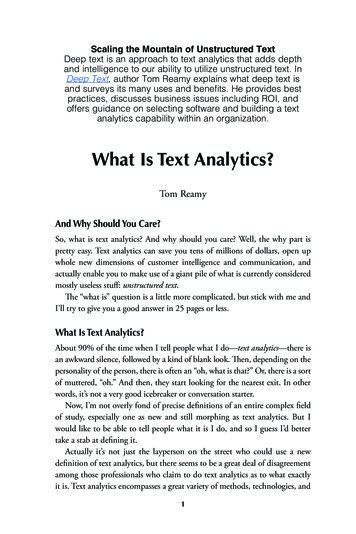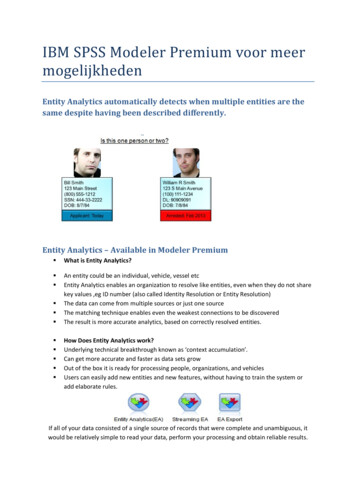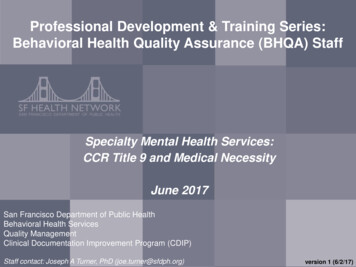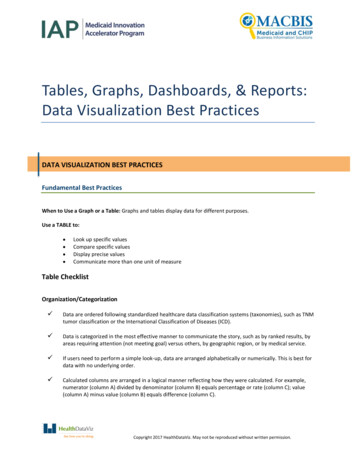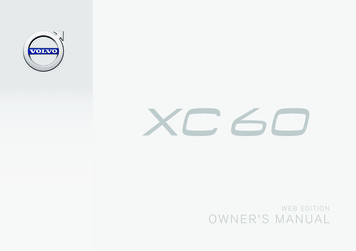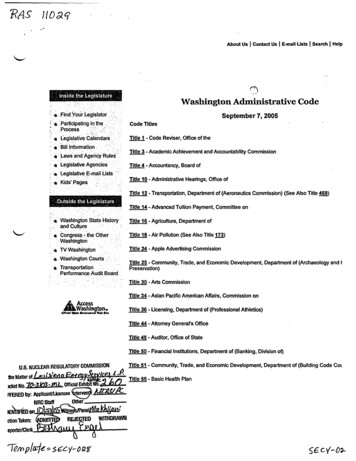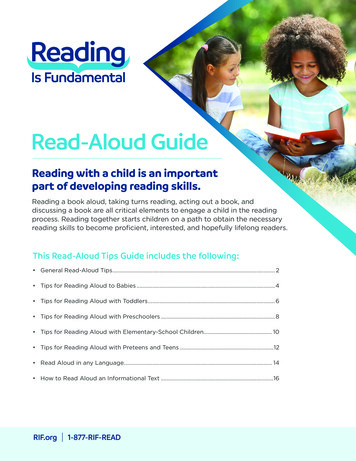
Transcription
ELECTRONIC TEXT DISPLAYS: READING REHABILITATION OF LOWVISION PATIENTS WITH AGE-RELATED MACULAR DEGENERATIONByKathy AquilanteDISSERTATIONIn partial satisfaction of the requirements for the degree ofDoctor of PhilosophyinVision ScienceGraduate program State University of New YorkState College of OptometryMarch 26, 2003AcknowledgmentsA special thank you to my mentor and thesis advisor Dr. Dean YagerThank you to my committee memebersDr. William H. SwansonDr. Philip KrugerAnd for making this work possible thank you to the National Institutes of Health forgrants K23-EY-00366 (KA) and R01-EY-11617 (DY) and to the Schnurmacher Institutefor Vision Resarch at SUNY State College of Optometry1
ELECTRONIC TEXT DISPLAYS: READING REHABILITATION OF LOWVISION PATIENTS WITH AGE-RELATED MACULAR DEGENERATIONBACKGROUND AND SIGNIFICANCEAccording to the World Health Organization (WHO) blindness is the mostexpensive cause of serious disablement worldwide (WHO-Study-Group, 1973). Basedon fragmentary data, thought to underestimate the true of number of afflicted, the WHOstudy group estimates that there are at least 15 million blind persons. Blindness definedby WHO is best-corrected visual acuity of 20/400 or worse in the better eye (WHOStudy-Group, 1973). Most industrialized nations have adopted a standard that is differentthan the one developed by WHO for defining legal blindness, using best-corrected visualacuity that is equal to or worse than 20/200 in the better eye. The WHO Study Group didnot provide world-wide estimates of the number of persons with visual impairment(defined as best-corrected visual acuity of less than 20/70 but better than 20/400) eventhough this level of vision loss can cause disability (WHO-Study-Group, 1973). WHOdefines disability as the lost "ability to perform a specific task" resulting from anymeasurable loss of functional capability (impairment) (Leat, Legge & Bullimore, 1999;Massof, Dagnelie, Deremeik, Suleiman & Glasner, 1995; WHO-Study-Group, 1973).The International Classification of Impairments, Disabilities and Handicaps(ICIDH) developed by WHO attempts to standardize the description of the consequencesof disease (WHO Study Group, 1973; (Dickinson, 1998; Leat, et al., 1999; Massof, et al.,1995). In the WHO standard there are two categories of visual impairment: (1) visual2
acuity less than 20/70 but better than 20/200, and (2) visual acuity less than 20/200 butbetter than 20/400. Impairment may result from any physiological "disorder". Forexample, the disorder of age-related maculopathy involves the progressive degenerationof photoreceptors in the macula. A disorder results in an impairment when a patient doesnot perform as well as "normal" on a standardized test, such as visual acuity (Dickinson,1998; Leat, et al., 1999). If the impairment results in a lost capacity to perform a specifictask that is necessary for maintaining that individual’s desired lifestyle, then a disabilityis present. If no compensation can be made to overcome the disability, then theindividual becomes handicapped (Leat, et al., 1999; Massof, et al., 1995; WHO-StudyGroup, 1973).Eligibility for funding for low vision aids, rehabilitative intervention, and supportservices intended to overcome handicaps, is dependent on the classification anddefinitions of visual impairment and visual disability (Leat, et al., 1999). In the UnitedStates, rehabilitative services to visually impaired and legally blind persons have beenfunded primarily through the U.S. Department of Education (Massof & Lidoff, 2001).Allocation of funding is determined by each state. In New York State the range ofavailable services varies on a case by case basis. Persons who do not have educational orvocational goals are eligible for services only if they are legally blind, and the resourcesavailable for this group are very limited (Massof & Lidoff, 2001). The reportedprevalence of legal blindness is variable, ranging from 3% to 8.2% for persons over theage of 85 years compared to less than 1% of the population under 75 years (Brabyn,Haegerstrom-Portnoy, Schneck & Lott, 2000). There are many individuals who are notlegally blind who have a disability due to a visual impairment (Leat, et al., 1999). The3
majority of patients who seek low vision care in order to overcome a disability are overage 65 (Elliott, Trukolo-Ilic, Strong, Pace, Plotkin & Bevers, 1997) and do not haveeducational or vocational goals. For this population the optical devices and assistivetechnology that are necessary for overcoming potentially handicapping vision loss are anout-of-pocket expense.In the United States there is no nationally agreed upon standard for defining levelsof visual impairment other than legal blindness (Brabyn, et al., 2000). Many states havea legal criterion of best-corrected visual acuity of 20/40 as the cutoff for an unrestricteddriver’s license (Brabyn, et al., 2000; Tielsch, 2001). In most states entitlement toeducational services for the visually impaired requires best-corrected visual acuity equalto or worse than 20/70 (Brabyn, et al., 2000).A standard that defines visual impairment as best-corrected visual acuity worsethan 20/70 may not be adequate (Legge, Pelli, Rubin & Schleske, 1985a; Legge, Rubin,Pelli & Schleske, 1985b; Tielsch, 2001). Several investigators argue that impairment bedefined as best-corrected visual acuity worse than 20/40 but better than 20/200 in thebetter eye (Legge, et al., 1985b; Tielsch, 2001). Low vision has been defined as theinability to read a newspaper, with best spectacle correction, at a normal reading distance(40 cm) (Legge, et al., 1985a; Legge, et al., 1985b). Further, the use of high contrastvisual acuity charts may not provide a true measure of the impact that vision loss has ineveryday situations, particularly for the elderly (Brabyn, et al., 2000; Charness &Dijkstra, 1999; Friedman, Munoz, Rubin, West, Bandeen-Roche & Fried, 1999;Haegerstrom-Portnoy, Schneck & Brabyn, 1999; Rubin, Roche, Prasada-Rao & Fried,1994). Under conditions of low luminance and reduced contrast 57% of subjects 854
years of age and older had visual acuity worse than 20/200 compared to 4% when themeasure was high contrast acuity (Brabyn, et al., 2000). By comparison, the sameconditions of low luminance and reduced contrast resulted in 24% of adults under age 55failing to attain visual acuity of 20/40. No subjects in the younger age group werereduced to worse than 20/70 visual acuity under conditions of low luminance and reducedcontrast (Brabyn, et al., 2000).More than three million people in the United States suffer from impaired vision tothe extent of being unable to read ordinary print with corrective lenses (Lighthouse,National, Survey, on, Vision & Loss, 1995; Tielsch, Sommer, Witt, Katz & Royall,1990). Shifts in the age distribution of the population are expected to result in a doublingof the number of visually impaired and legally blind persons by the year 2030 (Bureau,of, the, Census, U.S., Department, of & Commerce, 1996).Age-related macular degeneration (AMD) is the leading cause of irreversiblecentral vision loss in persons older than 65 years of age. Between 4 and 10 millionpeople in the United States are estimated to have AMD (Berger, Fine & Maguire, 1999;Kini, Leibowitz & Colton, 1978; Klein, Klein & Linton, 1992; Sommer, Tielsch, Katz,Quigley, Gottsch, Javitt, Martone, Royall, Witt & Ezrine, 1991). The prevalence of AMDin the United States is strongly age-related with rates of 1.6% in 52-64 years olds, 11% in65-74 year olds, and 27.9% in those 75 years or older (Leibowitz, Krueger, Maunder,Milton, Kini, Kahn, Nickerson, Pool, Colton, Ganley, Loewenstein & Dawber, 1980).Similar findings were reported in a recent population-based cross-sectional study fromAustralia. AMD increased from 0% in 40-49 year old participants to 27% of participants90 years or older (VanNewkirk, Nanjan, Wang, Mitchell, Taylor & McCarty, 2000).5
Early anatomical signs of AMD have been defined as the presence of soft distinct,soft indistinct, or reticular drusen, or the presence of retinal pigmentary abnormalities inthe absence of late AMD lesions (VanNewkirk, et al., 2000). When early signs of AMDare included in prevalence studies almost three quarters of people who reach the age of90 years can be expected to have age-related maculopathy (VanNewkirk, et al., 2000).One third of all cases have late AMD defined as “wet AMD” (neovascular) or “dryAMD” (geographic atrophy) (VanNewkirk, et al., 2000). Severe vision loss occurswhenever choroidal neovascularization or geographic atrophy of the retinal pigmentepithelium involves the foveal center (Ferris, Fine & Hyman, 1984). In the United Statesapproximately 540,000 people are estimated to have late AMD (Klein, Klein, Jensen,Mares-Perlman, Cruickshanks & Palta, 1999). Because individuals over 65 years old areone of the fastest growing sectors of the population, AMD is a major public healthproblem (Seddon, Ajani, Sperduto, Hiller, Blair, T.C, Farber, Gragoudas, Haller, Miller,Yannuzzi, Willett, Eye, Disease, Case-Control, Study & Group, 1994).There are currently no effective treatments for the vast majority, about 80%, ofpatients who have the non-neovascular (dry) form of AMD (Ferris, et al., 1984; National,Advisory, Eye & Council, 1998). The neovascular form however may account for almost90% of cases with severe visual loss and legal blindness (Ferris, et al., 1984; Hyman,Lilienfeld, Ferris & Fine, 1991; Kahn, Leibowitz & Ganley, 1977). Age-related maculardegeneration (AMD) accounts for approximately 50% of annual blind and partiallysighted registrations in Britain (Russell, Harper, Reeves, Waterman, Henson & McLeod,2001). In the Beaver Dam eye study, 57 % of legally blind had late AMD (Klein, Wang,Klein, Moss & Meuer, 1995). In the Baltimore Eye Study late AMD was the cause of6
30% of the white population who were legally blind (Sommer, et al., 1991). In theFramingham Eye Study exudative AMD was present in 79% of legally blind eyes (Kahn,et al., 1977). For some forms of choroidal neovascularization, secondary to AMD, lasertreatment is more successful than observation in postponing or limiting severe vision lossbut treated eyes also lose vision after laser treatment (Bressler & Bressler, 1995).Currently, there is no treatment that restores visual function in the presence of thesevere late dry form of AMD geographic atrophy (Sunness, Rubin, Applegate, Bressler,Marsh, Hawkins & Haselwood, 1997). Geographic atrophy (GA) is present in 3.5% ofpeople 75 years of age or older and it is responsible for 20% of the cases of legalblindness due to AMD, and for a much larger percentage of cases of moderate visual loss(Sunness, 1999). Areas of GA are associated with absolute scotoms (Sunness, et al.,1997).Patients with advanced forms of AMD tend to have bilateral involvement(Macular, Photocoagulation, Study & Group, 1993) and central visual field loss (CFL)(Bressler & Bressler, 1995; Ferris, et al., 1984; Macular, et al., 1993; Sunness, et al.,1997). Research has demonstrated that CFL results in devastating reading disability inthe form of very slow reading rates (Elliott, Bhavesh, & Whitaker 2001; Legge et al.1985b; Rubin & Turano, 1994; (Fine & Peli, 1998; Legge, Ross, Luebker & LaMay,1989; Sunness, Applegate, Haselwood & Rubin, 1996). Several factors may contribute tothe slow reading rates of low vision patients. The visual span is reduced in low vision;fewer characters are recognized in a single glance, and it takes longer to recognize wordsthat exceed the visual span because more than one fixation is required (Legge, Ahn, Klitz& Luebker, 1997; Legge, Mansfield & Chung, 2001). For subjects with normal vision7
reading around artificial scotomas, reading rate decreases as the number of lettersoccluded by a scotoma increases (Fine & Rubin, 1999).Low vision patients with CFL have eye movement characteristics that aredifferent from readers with normal vision (Bullimore & Bailey, 1995; McMahon, Hansen& Viana, 1991; Rubin & Turano, 1994). Readers with AMD and CFL take longer toinitiate saccades to simple targets (White & Bedell, 1990; Whittaker, Cummings &Swieson, 1991), and traverse fewer letters per forward saccade when reading thansubjects with normal vision (Bullimore & Bailey, 1995; McMahon, et al., 1991).Frequent small saccades may slow reading rates because small saccades have longerlatencies and result in longer fixations between saccades (Kowler & Anton, 1987).The main objective of most elderly patients who seek care from a low-visionclinic is to gain improvement in personal reading (Elliott, et al., 1997; Faye, 1970; Hall,Sacks, Dornbusch & Raasch, 1987; Krieger, 1967). Reading is critical to fullparticipation in modern society and includes reading for survival (medicine labels, bills,and bank statements), and reading for vocation or pleasure (books, magazines, andnewspapers). Loss of the ability to read, due to low vision, affects the ability to functionindependently for simple everyday tasks such as shopping (Legge, et al., 1985b). Evenmild visual impairment (visual acuity worse than 20/40) is associated with difficulty intasks necessary for independent living, including: house-work, paying bills, and shopping(West, Munoz, Rubin, Schein, Bandeen-Roche, Zeger, German & Fried, 1997).The goal of low vision rehabilitation is to restore function (Massof, et al., 1995).The successful outcome of rehabilitation for low vision patients often depends on thesuccess or failure of optical devices prescribed for reading (Lovie-Kitchin & Whittaker,8
1999). Reading performance is strongly associated with vision-related quality of life(Hazel, Petre, Armstrong, Benson & Frost, 2000). Individual patients perceive thebenefits they attain from visiting a low vision clinic to be as high as 89.5% (Leat, Fryer &Rumney, 1994). In spite of the perceived benefit the ability to read normal-sized printwith optical devices may be as high as 75% in the clinic but drop to only 35% for thepatients at home (Leat, et al., 1994). The discrepancy between in-office performancewith optical devices and reported home use may include differences in lighting, printquality and contrast, difficulty remembering instructions, and deteriorating vision (Leat,et al., 1994). To assure fluent reading after the patient leaves the clinic much highermagnification should be prescribed than the threshold size that just allows the patient toread standard sized print (Lovie-Kitchin & Whittaker, 1999). Optical devices thatprovide high magnification have many limitations, including reading distances as close asone inch, a field of view that may be smaller than a single word, the need forconsiderable manual dexterity, and hours of practice for proficient use (Goodrich, Mehr,Quillman, Shaw & Wiley, 1977). Each of these factors limits reading performance andcauses frustration for patients.For readers with severe vision loss, a closed-circuit television (CCTV) is often thevisual aid of choice (Arditi, 1999). A CCTV consists of a video monitor and a verticallymounted camera that is aimed at the reading material on a moveable platform. A CCTVcan provide high magnification, high contrast, and a larger field of view than standardlow vision devices. Patients prefer CCTVs for extended reading, and are reported to usethem for longer durations compared to other low vision devices (Goodrich & Kirby,2001; Watson, De l'Aune, Long, Maino & Stelmack, 1997). However, the navigation9
demands of using a CCTV significantly lengthens the time required for reading comparedto computerized presentation methods (Beckmann & Legge, 1996; Harland, Legge &Luebker, 1998).Computer generated displays can alter text format, providing much greatermagnification, higher contrast, and a less restricted field of view (Fine & Peli, 1995; Fine& Peli, 1996b). When high magnification is needed a simple computer and television canprovide access to print that cannot be read by other means.Electronic magnification and presentation technology has been used to investigatereading in low vision (Fine & Peli, 1995; Legge, et al., 1985b; Rubin & Turano, 1994).There is a trend for reading speed to increase as the number of letters in the field of viewincreases (Fine & Peli, 1996b; Harland, et al., 1998; Lovie-Kitchin & Woo, 1988).Dynamic displays, such as text that scrolls from right to left (SCROLL) (Legge, et al.,1989), and RSVP (Rapid Serial Visual Presentation) (Rubin & Turano, 1992; Rubin &Turano, 1994), which presents one word at a time, result in faster reading rates for mostlow vision subjects compared to conventional page formats. RSVP is often the fastestmethod if the text size is very large, though some low vision patients have been found toread SCROLL faster than RSVP regardless of text size (Fine & Peli, 1998).While reading speed is often the dependent variable in reading research, andreading speed is important for general visual quality of life (Hazel, et al., 2000), accuracymay be more important to low vision patients (Leat, et al., 1994). The ability to performa variety of daily activities such as reading bank statements, personal letters, instructions,and labels is associated with perceived benefit from low vision rehabilitation (Leat, et al.,1994). Computer systems should be the recommended reading aid when standard optical10
devices do not provide adequate magnification and or a wide enough field of view toallow accurate reading at maximum rate. Computer systems, via the World Wide Web,can increase access to text for low vision patients for both extended reading (newspapersor books) and spot reading (bank statements or instructions) for personal independenceand safety (Leat, et al., 1999).The benefits of using computer technology to alter text displays are not alwaysclear-cut for low vision patients with CFL from AMD (Fine & Peli, 1996b; Fine & Peli,1998; Harland, et al., 1998; Legge, et al., 1989; Rubin & Turano, 1994). While clearguidelines to maximize reading for patients with CFL have been difficult to make,advances in video technology are likely to benefit this group (Arditi, 1999; Fine & Peli,1996a).11
ReferencesArditi A.(1999).Elicited sequential presentation for low vision reading.VisionRes.39:4412-4418.Beckmann PJ, Legge GE.(1996).Psychophysics of reading XIV. The page navigationproblem in using magnifiers.Vision Res.36:3723-3733.Berger JW, Fine SL, Maguire MG.(1999)Age-related Macular Degeneration.Age-relatedMacular Degeneration.St. Louis:Mosby.Pages.Brabyn JA, Haegerstrom-Portnoy G, Schneck ME, Lott LA.(2000).Visual impairments inelderly people under everyday viewing conditions.J Vis Impair Blind.94:741-755.Bressler NM, Bressler SB.(1995).Preventive Ophthalmology. Age-related llimore MA, Bailey IL.(1995).Reading and eye movements in age-relatedmaculopathy.Optom Vis Sci.72:125-138.Bureau, of, the, Census, U.S., Department, of, Commerce.(1996)Population projectionsof the United States by age, sex, race, and Hispanic origin: 1995 to2050.Population projections of the United States by age, sex, race, and Hispanicorigin: 1995 to 2050.Washington, D.C.:Charness N, Dijkstra K.(1999).Age, luminance and print legibility in homes, offices andpublic places.Human Factors.41:173-193.Dickinson C.(1998)Low Vision. Principles and Practice.Low Vision. Principles andPractice.Oxford:Butterworth Heinemann.Pages.Elliott DB, Trukolo-Ilic M, Strong JG, Pace R, Plotkin A, Bevers P.(1997).Demographiccharacteristics of the vision-disabled elderly.Invest Ophthalmol Vis Sci.38:25662575.Faye EE.(1970)The Low Vision Patient: Clinical Experience with Adults andChildren.The Low Vision Patient: Clinical Experience with Adults andChildren.New York:Grune and Stratton.Pages.Ferris FLI, Fine SL, Hyman L.(1984).Age-related macular degeneration and blindnessdue to neovascular maculopathy.Arch Ophthalmol.102:1640-1612.Fine EM, Peli E.(1995).Enhancement of text for the visually impaired.J Opt Soc AmA.12:1439-1447.Fine EM, Peli E.(1996a).The role of context in reading with central field loss.Optom VisSci.73:533-539.Fine EM, Peli E.(1996b).Visually impaired observers require a larger window thannormally sighted observers to read from a scroll display.J Am OptomAssoc.67:390-396.Fine EM, Peli E.(1998).Benefits of rapid serial visual presentation (RSVP) over scrolledtext vary with letter size.Optom Vision Sci.75:191-196.Fine EM, Rubin GS.(1999).Reading with central field loss: number of letters masked ismore important than the size of the mask in degrees.Vision Res.39:747-756.Friedman SM, Munoz B, Rubin GS, West SK, Bandeen-Roche K, Fried LP.(1999).Characteristics of discrepancies between self-reported visual function and12
measured reading speed. Salisbury Eye Evaluation Project Team.InvestOphthalmol Vis Sci.40:858-864.Goodrich GL, Kirby J.(2001).A comparison of patient reading performance andpreference: optical devices, handheld CCTV (Innoventions Magni-Cam), orstand-mounted CCTV (Optelec Clearview or TSI Genie).J Am OptomAssoc.72:519-528.Goodrich GL, Mehr EB, Quillman RD, Shaw HK, Wiley JK.(1977).Training and practiceeffects in performance with low-vision aids: A preliminary study.Am J OptomPhysiol Optics.54:312-318.Haegerstrom-Portnoy G, Schneck ME, Brabyn JA.(1999).Seeing into Old Age: VisionFunction Beyond Acuity.Optom Vision Sci.76:141-158.Hall A, Sacks SZ, Dornbusch H, Raasch T.(1987).A preliminary study to evaluateservices in a low vision clinic.J Vis Rehab.1:7-25.Harland S, Legge GE, Luebker A.(1998).Psychophysics of reading. XVII. Low-visionperformance with four types of electronically magnified text.Optom VisSci.75:183-190.Hazel CA, Petre KL, Armstrong RA, Benson MT, Frost NA.(2000).Visual function andsubjective quality of life compared in subjects with acquired maculardisease.Invest Ophthalmol Vis Sci.41:1309-1315.Hyman L, Lilienfeld AM, Ferris FL, Fine SL.(1991).Senile macular degeneration: a casecontrol study.Am J Epidemiol.118:213-227.Kahn HA, Leibowitz HM, Ganley JP.(1977).The Framingham eye study, I: outline andmajor prevalence findings.Am J Epidemiol.106:17-32.Kini MM, Leibowitz HM, Colton T.(1978).Prevalence of senile cataract, diabeticretinopathy, senile macular degeneration, and open-angle glaucoma in theFramingham Eye Study.Am J Ophthalmol.85:Klein R, Klein BEK, Jensen SC, Mares-Perlman JA, Cruickshanks KJ, Palta M.(1999).Age-related maculopathy in a multiracial United States population. TheNational Health and Nutrition Examination Survey III.Ophthalmology.106:10561065.Klein R, Klein BEK, Linton KLP.(1992).Prevalence of age-related maculopathy: theBeaver Dam Eye Study.Ophthalmology.99:933-943.Klein R, Wang Q, Klein BE, Moss SE, Meuer SM.(1995).The relationship of age-relatedmaculopathy, cataract, and glaucoma to visual acuity.Invest Ophthalmol VisSci.36:182-191.Kowler E, Anton S.(1987).Reading twisted text: Implications for the role of saccades.VisResearch.27:45-60.Krieger AA.(1967).The partially sighted patient: A study of 917 cases.Trans AmOphthalmol Soc.65:544-590.Leat SJ, Fryer A, Rumney NJ.(1994).Outcome of low vision aid provision: Theeffectiveness of a low vision clinic.Optom Vision Sci.71:199-206.Leat SJ, Legge GE, Bullimore MA.(1999).What is low vision? A Re-evaluation ofdefinitions.Optom Vis Sci.76:198-211.Legge GE, Ahn SJ, Klitz TS, Luebker A.(1997).Psychophysics of reading--XVI. Thevisual span in normal and low vision.Vision Res.37:1999-2010.13
Legge GE, Mansfield JS, Chung ST.(2001).Psychophysics of reading. XX. Linking letterrecognition to reading speed in central and peripheral vision.Vision Res.41:725743.Legge GE, Pelli DG, Rubin GS, Schleske MM.(1985a).Psychophysics of reading I.Normal Vision.Vision Res.25:239-252.Legge GE, Ross JA, Luebker A, LaMay JM.(1989).Psychophysics of reading. VIII. TheMinnesota Low-Vision Reading Test.Optom Vis Sci.66:843-853.Legge GE, Rubin GS, Pelli DG, Schleske MM.(1985b).Psychophysics of reading II. LowVision.Vision Res.25:253-266.Leibowitz HM, Krueger DE, Maunder LR, Milton RC, Kini MM, Kahn HA, NickersonRJ, Pool J, Colton TL, Ganley JP, Loewenstein JI, Dawber TR.(1980).TheFramingham Eye Study monograph.Surv Ophthalmol.24(suppl):335-610.Lighthouse, National, Survey, on, Vision, Loss.(1995)The experience, attitude, andknowledge of middle-aged and older Americans.The experience, attitude, andknowledge of middle-aged and older Americans.New York:Lighthouse.Pages.Lovie-Kitchin JE, Whittaker SG.(1999).Prescribing near magnification for low visionpatients.Clin Exp Optom.82:214-224.Lovie-Kitchin JE, Woo GC.(1988).Effect of magnification and field of view on readingspeed using a CCTV.Ophthalmic Physiological Optics.8:139-145.Macular, Photocoagulation, Study, Group.(1993).Five-year follow-up of fellow eyes ofpatients with age-related macular degeneration and unilateral extrafovealchoroidal neovascularization.Arch Ophthalmol.111:1189-1199.Massof RW, Dagnelie G, Deremeik JL, Suleiman SA, Glasner NM.(1995).Low visionrehabilitation in the US health care system.Journal of Vision Rehabilitation.9:325.Massof RW, Lidoff L.(2001)Issues in Low Vision Rehabilitation. Service Delivery,Policy, and Funding.Issues in Low Vision Rehabilitation. Service Delivery,Policy, and Funding.New York:AFB Press.Pages.McMahon TT, Hansen M, Viana M.(1991).Fixation characteristics in macular disease:Relationship between saccadic frequency, sequencing and reading rate.InvestOphthalmol Vis Sci.32:567-574.National, Advisory, Eye, Council.(1998).Report of the Retinal Diseases Panel.In: VisionResearch; A National Plan:1999-2003.Services USDoHaHeditorBethesda:National Institutes of Health publication 98-4120.13-40.Rubin GS, Roche KB, Prasada-Rao P, Fried LP.(1994).Visual impairment and disabilityin older adults.Optom Vis Sci.71:750-760.Rubin GS, Turano K.(1992).Reading without saccadic eye movements.VisionRes.32:895-902.Rubin GS, Turano K.(1994).Low vision reading with sequential word presentation.VisionRes.34:1723-1733.Russell W, Harper R, Reeves B, Waterman H, Henson D, McLeod D.(2001).Randomisedcontrolled trial of an integrated versus an optometric low vision rehabilitationservice for patients with age-related macular degeneration: study design andmethodology.Ophthal Physiol Opt.21:36-44.Seddon JM, Ajani UA, Sperduto RD, Hiller R, Blair N, T.C B, Farber M, Gragoudas E,Haller J, Miller DT, Yannuzzi LA, Willett W, Eye, Disease, Case-Control, Study,14
Group.(1994).Dietary Carotenoids, Vitamins A, C, and E, and Advanced AgeRelated Macular Degeneration.JAMA.272:1413-1420.Sommer A, Tielsch JM, Katz J, Quigley HA, Gottsch JD, Javitt JC, Martone JF, RoyallRM, Witt K, Ezrine S.(1991).Racial differences in the cause-specific prevalenceof blindness is east Baltimore.N Engl J Med.325:1412-1417.Sunness JS.(1999).The use of the scanning laser ophthalmoscope in the geographicatrophy form of advanced age-related macular degeneration.In: Vision '99:International Conference on Low Vision. Vision Rehabilitation for the 21stcentury.New York:Lighthouse International.99.Sunness JS, Applegate CA, Haselwood D, Rubin GS.(1996).Fixation patterns andreading rates in eyes with central scotomas from advanced atrophic age-relatedmacular degeneration and Stargardt Disease.Ophthalmology.103:1458-1466.Sunness JS, Rubin GS, Applegate CA, Bressler NM, Marsh MJ, Hawkins BS, HaselwoodD.(1997).Visual function abnormalities and prognosis in eyes with age-relatedgeographic atrophy of the macula and good visualacuity.Ophthalmology.104:1677-1691.Tielsch JM.(2001).Prevalence of Visual Impairment and Blindness in the UnitedStates.In: Issues in Low Vision Rehabilitation. Service Delivery, Policy, andFunding.Massof RW,Lidoff L editors.New York:AFB Press.13-26.Tielsch JM, Sommer A, Witt K, Katz J, Royall RM.(1990).Blindness and VisualImpairment in an American Urban Population.Arch Ophthalmol.108:286-290.VanNewkirk MR, Nanjan MB, Wang JJ, Mitchell P, Taylor HR, McCarty C.(2000).Theprevalence of age-related maculopathy. The visual impairmentproject.Ophthalmology.1593-1600:Watson GR, De l'Aune W, Long S, Maino J, Stelmack JA.(1997).Veterans' use of lowvision devices for reading.Optom Vis Sci.74:260-265.West SK, Munoz B, Rubin GS, Schein OD, Bandeen-Roche K, Zeger S, German S, FriedLP.(1997).Function and visual impairment in a population-based study of olderadults. The SEE project. Salisbury Eye Evaluation.Invest Ophthalmol VisSci.38:72-82.White JM, Bedell HE.(1990).The oculomotor reference in humans with bilateral maculardisease.Invest Ophthalmol Vis Sci.31:1149-1161.Whittaker SG, Cummings RW, Swieson LR.(1991).Saccade control without afovea.Vision Res.31:2209-2218.WHO-Study-Group.(1973)The Prevention of Blindness. World Health OrganizationTechnical Report Series, Report No. 518.The Prevention of Blindness. WorldHealth Organization Technical Report Series, Report No. 518.Geneva:WorldHealth Organization.Pages.15
Title: Within-session practice of computer-generated reading methods for low visiondue to age-related macular degenerationAuthors: Kathy Aquilante, Dean Yager, Robert A MorrisCorresponding author: Kathy Aquilante, O.D., Ph.D., Assistant Professor, SUNY StateCollege of Optometry, 33 West 42nd St., NY NY 10013212-780-5152212-780-5137 faxaquilante@sunyopt.eduDean Yager, Ph.D., Distinguished Professor, SUNY College of OptometryRobert A. Morris, Ph.D., Professor of Mathematics and Computer Science, University ofMassachusetts, Boston MA16
Summary. The purpose of this study was to investigate whether reading performance,measured in words per minute, improved during an hour of within-session practice. Thereading methods were three computer-generated presentations including (1) MNREAD, amodified page format, (2) RSVP, which presents one word at a time, and (3) SCROLL,where text pans from right to left across a screen. Forty-five young readers with normalvision, forty-five elder readers with normal vision, and forty-five readers with low visiondue to age-related macular
ELECTRONIC TEXT DISPLAYS: READING REHABILITATION OF LOW VISION PATIENTS WITH AGE-RELATED MACULAR DEGENERATION By Kathy Aquilante DISSERTATION In partial satisfaction of the requirements for the degree of Doctor of Philosophy in Vision Science Graduate program State University of New York State College of Optometry March 26, 2003 Acknowledgments



